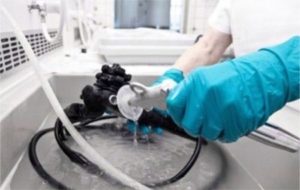 In today’s environment, Endoscopy and PeriOperative departments need to be very careful to follow their endoscope reprocessing protocols extremely closely. With all the reports of superbug outbreaks due to the inadequate disinfection of scopes, it is the primary job of sterile processing (or whichever department oversees reprocessing scopes) to provide safe endoscopes to use on patients.
In today’s environment, Endoscopy and PeriOperative departments need to be very careful to follow their endoscope reprocessing protocols extremely closely. With all the reports of superbug outbreaks due to the inadequate disinfection of scopes, it is the primary job of sterile processing (or whichever department oversees reprocessing scopes) to provide safe endoscopes to use on patients.
On the business side of the equation, Endoscopy and PeriOperative departments must also ensure that their operations are run smoothly and efficiently. A big part of that job is to make sure that endoscopes are reprocessed efficiently so that the turnaround times between endoscope usages are minimized. The endoscope reprocessing cycle can be broken down into 3 main components:
- Time to get from bedside to the sterile processing department (SPD): In this step it is critical to make sure that endoscopes are quickly cleaned at the bedside after each procedure and returned to SPD. Communication protocols must be established that allow for the efficient return of scopes to SPD.
- Time to go through the entire reprocessing cycle: Once an endoscope reaches SPD, staff must make sure to efficiently put each scope through the entire reprocessing cycle. Any scopes that spend too much time in any part of the reprocessing cycle (such as the sink clean or AER cycle) can create a snowball of delays – much like small delays at an airport leading to big delays later in the day due to the cascading effects of traffic. Staff must be trained to be vigilant in moving scopes from one step to the next, and not letting them linger too long in one area.
- Time to get from reprocessing to clean storage: The final step of endoscope reprocessing is returning the disinfected scope to clean storage. In this step, it is purely good communication and clear protocols that will ensure that scopes don’t get held up between SPD and the endoscope storage area.
If a department experiences delays in any or several of these steps, inefficiencies are sure to occur. Managers must constantly monitor this data to make sure that any bottlenecks in the reprocessing cycle are identified and systematically eliminated.
If Endoscopy or PeriOp is allowing delays to happen in the reprocessing cycle, they are risking patient safety and department profitability. If scopes are not turned around fast enough for use in the next procedure, patients may have to wait for scopes to become available before their procedure can begin. This introduces unnecessary patient risks into the department. The business risks of an inefficient reprocessing cycle are delayed or canceled cases. These often avoidable situations result in financial harm to the department. Some hospitals may try to cover up for reprocessing inefficiencies by inflating the number of scopes that they own, which leads to its own financial issues.
To keep your scope reprocessing cycles running efficiently, you need to have access to accurate data that breaks down how long each step of the reprocessing cycle takes. With that data in hand, bottlenecks can be identified, and targets can be set to systematically reduce the bottlenecks until they are eliminated. Slow moving employees can also be identified to make sure that they good performers are rewarded while the slower performers are given the opportunity to improve. Without this data, bottlenecks are likely to persist because benchmarks cannot be set, and measurement of performance cannot adequately be tracked.
Scope reprocessing efficiency data has the potential to bring massive productivity gains to your Endoscopy or PeriOperative department. Academic medical centers and large health systems especially require this data due to the sheer number of scopes they must reprocess and the large areas their scopes travel across. Scope tracking systems, such as iRIScope from Mobile Aspects, help manage the tracking and usage of an entire endoscope inventory, and include analyses of scope reprocessing efficiency based on timestamps automatically gathered by the system. Data can be reviewed and targets can be set and tracked to drive improvements to the scope reprocessing cycle. iRIScope also helps track down missing scopes by recording a real-time chain of custody, so missing scopes can be identified and tracked down immediately. iRIScope will also help manage all of the usage, reprocessing and repair details of your entire scope inventory, and will offer up actionable analytics on how to improve the management of your expensive scopes. Built in patient safety features also minimize the risk from adverse health events caused by inadequately reprocessed scopes.
